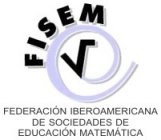Qué motiva a las mujeres a estudiar Matemáticas: un estudio de caso
Resumen
Se reporta una investigación con el objetivo de identificar los factores que han motivado a estudiantes universitarias a elegir una licenciatura en Matemáticas. Los datos reportados fueron generados a través de 15 entrevistas semiestructuradas aplicadas a estudiantes de la licenciatura en Matemáticas de la (UAGro) en México. Algunos factores identificados son: gusto por las matemáticas y que se sientan buenas en matemáticas. Nos apoyamos en el concepto teórico identidad para argumentar que los factores que hemos identificado son elementos constituyentes de una identidad positiva como estudiantes de matemáticas, esto favorece la elección de las matemáticas como carrera universitaria.
Descargas
Citas
Aguilar, M. S., Vázquez, A. R., Mendoza, A. R., Zavaleta, J. G. M. y Alonso, A. C. (2013). Factors motivating the choice of mathematics as a career among mexican female students. En B. Ubuz, C. Haser y Mariotti, M.A. (Eds.), Proceedings of the Eighteenth Congress of the European Society for Research in Mathematics Education (1409-1418). Turquía: European Society for Research in Mathematics Education.
Anderson, R. (2007). Being a mathematics learner: four faces of identity. The Mathematics Educator, 17(1), 7–14.
ANUIES (2014). Anuario educación superior-licenciaturas. Anuarios estadísticos de educación superior. [base de datos]. D.F., México: ANUIES.
Barrera, P. S. (2012). Mujeres matemáticas en México. Ciencia, 63 (3), 44–53.
Buerk, D. (1983). An experience with some able women who avoid mathematics. For the Learning of Mathematics, 3(2), 19–24.
Black, L. y Williams, J. (2013). Contradiction and conflict between ‘leading identities’ : becoming an engineer versus becoming a ‘good muslim’ woman. Educational Studies in Mathematics, 84(1), 1–14.
Cerinsek, G., Hribar, T., Glodez, N. y Dolinsek, S. (2013). Which are my future career priorities and what influenced my choice of studying science, technology, engineering or mathematics? Some insights on educational choice-Case of Slovenia. International Journal of Science Education, 35(17), 2999–3025.
De Guzmán, M., Hodgson, B., Robert, A. y Villani, V. (1998). Difficulties in the passage from secondary to tertiary education. Proceedings of the International Congress of Mathematicians, 3, 747–762.
Del Giudice, M. (2014). Why it’ s crucial to get more women into science. National Geographic [en línea]. Recuperado el 8 de diciembre de 2016, de http://news.nationalgeographic.com/news/2014/11/141107-gender-studies-womenscientific-research-feminist/
European Commission (2009). Statistics and Indicators on Gender Equality in Science. She figures 2009. Bruselas: European Commission.
Forgasz, H., Leder, G. y Tan, H. (2014). Public views on the gendering of mathematics and related careers: international comparisons. Educational Studies in Mathematics, 87(3), 369–388.
Gee, J. P. (2001). Identity as an analytic lens for research in education. Review of Research in Education, 25(1), 99–125.
Hill, T. P. y Rogers, E. (2012). Gender gaps in science: the creativity factor. The Mathematical Intelligencer, 34(2), 19–26.
Holmegaard, H. T., Ulriksen, L. M. y Madsen, L. M. (2014). The process of choosing what to study: a longitudinal study of upper secondary students’ identity work whenchoosing higher education. Scandinavian Journal of Educational Research, 58(1), 21–40.
Kleanthous, I. y Williams, J. (2013). Perceived parental influence and students’ dispositions to study mathematically-demanding courses in higher education. Research in Mathematics Education, 15(1), 50–69.
Mendick, H. (2005). Mathematical stories: why do more boys than girls choose to study mathematics at AS-level in England? British Journal of Sociology of Education , 26(2), 235–251.
Onion, A. J. (2011). Women’ s stories of learning mathematics. Research in Mathematics Education, 13(3), 307–308.
Organisation for Economic Co-operation and Development (2008) EncouragingStudent Interest in Science and Technology Studies. Paris: OECD.
Pedersen, I. F. (2013). “I need advanced mathematics to pursue the career of my choice”. Norwegian students’ motivations for enrolling in mathematics and plans for postsecondary studies. Nordic Studies in Mathematics Education, 18(1), 61–83.
Piatek-Jimenez, K. (2008). Images of mathematicians: a new perspective on the shortage of women in mathematical careers. ZDM – Mathematics Education, 40(4),633–646.
Riessman, C. (2008). Narrative Methods for the Human Sciences. E.U.A.: Sage.
Sfard, A. y Prusak, A. (2005). Telling identities: In search of an analytic tool for investigating learning as a culturally shaped activity. Educational Researcher, 34(4), 14–22.
Stine, D. D. y Matthews, C. M. (2009). The U.S. Science and Technology Workforce. Washington, DC: Congressional Research Service.
Derechos de autor 2017 Rosa Iris Monico Manzano, Mario Sánchez Aguilar

Esta obra está bajo licencia internacional Creative Commons Reconocimiento 4.0.
El material publicado en la revista se distribuye bajo una licencia Creative Commons Reconocimiento Internacional 4.0 (CC-BY 4.0). Esta licencia permite a otros distribuir, mezclar, ajustar y construir a partir de su obra, incluso con fines comerciales, siempre que le sea reconocida la autoría de la creación original. Los autores de los trabajos publicados en Revista Unión retienen el copyright de los mismos sin restricción alguna.
Publicado 2017-04-16







.png)






